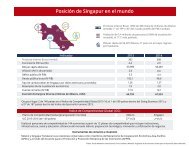basic-guide-to-exporting_Latest_eg_main_086196
basic-guide-to-exporting_Latest_eg_main_086196
basic-guide-to-exporting_Latest_eg_main_086196
You also want an ePaper? Increase the reach of your titles
YUMPU automatically turns print PDFs into web optimized ePapers that Google loves.
importing country will change. In the end, if the buyer cannot or will not pay for andclaim the goods, returning or disposing of the products becomes the problem ofthe exporter.Document against Acceptance CollectionA document against acceptance collection, also known as a time draft, is used whenthe exporter extends credit <strong>to</strong> the buyer. The draft states that payment is due by aspecific time after the buyer has accepted the time draft and received the goods.By signing and writing “accepted” on the draft, the buyer is formally obligated <strong>to</strong>pay within the stated time. When this is done, the time draft is then called a tradeacceptance. It can be kept by the exporter until maturity or sold <strong>to</strong> a bank at adiscount for immediate payment.A date draft differs slightly from a time draft in that it specifies a date on whichpayment is due, rather than a time period after acceptance of the draft. When either asight draft or a time draft is used, a buyer can delay payment by delaying acceptanceof the draft. A date draft can prevent this delay in payment, though the documentstill must be accepted.EscrowA number of online escrow services have been created as online alternatives <strong>to</strong>traditional forms of payment. The third party accepts and holds payment from thebuyer until the goods have been delivered.Open AccountIn a foreign transaction, an open account can be a convenient method of paymentif the buyer is well established, has a long and favorable payment record, or hasbeen thoroughly checked for creditworthiness. With an open account, the exportersimply bills the cus<strong>to</strong>mer, who is expected <strong>to</strong> pay under agreed terms at a futuredate. Obviously, this option is advantageous <strong>to</strong> the importer in terms of cash flowand cost, but it is consequently a risky choicefor an exporter. Because of intense competitionin export markets, foreign buyers often pressexporters for open-account terms. In addition,the extension of credit by the seller <strong>to</strong> the buyeris more common abroad. Therefore, exporterswho are reluctant <strong>to</strong> extend credit may lose asale <strong>to</strong> their competi<strong>to</strong>rs.An open account may be agood way <strong>to</strong> build trust with ar<strong>eg</strong>ular and reliable cus<strong>to</strong>mer.However, there are risks associated with open-account sales. The absence ofdocuments and banking channels, for example, might make it difficult <strong>to</strong> pursuethe l<strong>eg</strong>al enforcement of claims. The exporter might also have <strong>to</strong> pursue collectionabroad, which can be difficult and costly. Another problem is that receivablesmay be harder <strong>to</strong> finance because of the unavailability of drafts or other evidenceof indebtedness. It is possible <strong>to</strong> substantially mitigate the risk of nonpayment162U.S. Commercial Service • A Basic Guide <strong>to</strong> Exporting





